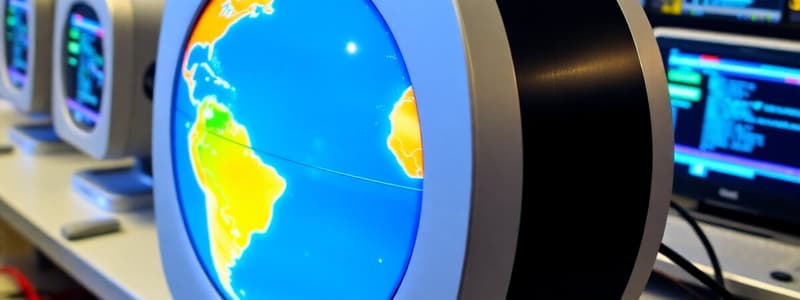Podcast
Questions and Answers
In a client/server network, the client is responsible for providing data, while the server requests it.
In a client/server network, the client is responsible for providing data, while the server requests it.
False (B)
Social networking sites such as Facebook and LinkedIn, inherently provide complete security and privacy for all user data.
Social networking sites such as Facebook and LinkedIn, inherently provide complete security and privacy for all user data.
False (B)
Podcasts utilize RSS (Really Simple Syndication) to deliver audio and video files, and aggregators are used to manage and organize these subscriptions.
Podcasts utilize RSS (Really Simple Syndication) to deliver audio and video files, and aggregators are used to manage and organize these subscriptions.
True (A)
Email is a synchronous form of communication, requiring immediate responses from recipients.
Email is a synchronous form of communication, requiring immediate responses from recipients.
Using a debit card for online purchases is generally safer than using a credit card due to the direct withdrawal from your bank account.
Using a debit card for online purchases is generally safer than using a credit card due to the direct withdrawal from your bank account.
Cloud computing involves storing and accessing data and applications exclusively from a single, dedicated device.
Cloud computing involves storing and accessing data and applications exclusively from a single, dedicated device.
In a B2C e-commerce model, businesses primarily sell products and services to other businesses.
In a B2C e-commerce model, businesses primarily sell products and services to other businesses.
Mobile commerce, or m-commerce, refers exclusively to transactions made through SMS or text messaging.
Mobile commerce, or m-commerce, refers exclusively to transactions made through SMS or text messaging.
Texting and Instant Messaging are asynchronous means of communication.
Texting and Instant Messaging are asynchronous means of communication.
Flashcards
The Internet
The Internet
A global network connecting countless computers, enabling secure communication and information sharing.
ARPANET
ARPANET
A network established by the U.S. Department of Defense to create a secure communication system.
HTML
HTML
Stands for Hypertext Markup Language. It is the language used to create documents on the World Wide Web.
World Wide Web
World Wide Web
Signup and view all the flashcards
Tim Berners-Lee
Tim Berners-Lee
Signup and view all the flashcards
Client/server network
Client/server network
Signup and view all the flashcards
Internet Protocol (IP) address
Internet Protocol (IP) address
Signup and view all the flashcards
Social Networking Sites
Social Networking Sites
Signup and view all the flashcards
Blog (weblog)
Blog (weblog)
Signup and view all the flashcards
Podcasts
Podcasts
Signup and view all the flashcards
E-mail
Signup and view all the flashcards
Texting/Instant Messaging
Texting/Instant Messaging
Signup and view all the flashcards
Cloud Computing
Cloud Computing
Signup and view all the flashcards
Business-to-Consumer (B2C)
Business-to-Consumer (B2C)
Signup and view all the flashcards
Business-to-Business (B2B)
Business-to-Business (B2B)
Signup and view all the flashcards
Consumer-to-Consumer (C2C)
Consumer-to-Consumer (C2C)
Signup and view all the flashcards
Social Commerce
Social Commerce
Signup and view all the flashcards
Mobile Commerce (m-commerce)
Mobile Commerce (m-commerce)
Signup and view all the flashcards
Secure Sockets Layer (SSL)
Secure Sockets Layer (SSL)
Signup and view all the flashcards
Web Browsers
Web Browsers
Signup and view all the flashcards
Study Notes
- Chapter 3 is titled "Using the Internet: Making the Most of the Web's Resources"
Origin of the Internet
- The Internet is a network of networks
- It established a secure form of communication
- Created a means of communication for all computers
- The Advanced Research Projects Agency Network (ARPANET) was an early packet switching network and the predecessor of the Internet
- In 1958, the Advanced Research Projects Agency (ARPA) was established for the U.S. Department of Defense
- ARPANET was the beginning of the Internet
- In 1963, ASCII code was developed as the standard for computers from different manufacturers to exchange data
- In 1964, a new network scheme was developed with multiple paths
- In 1969, researchers at UCLA sent the first message via a networked computer system to researchers at Stanford University
- The World Wide Web began in 1991
- It uses HTML
- Tim Berners-Lee developed it at the European Organization for Nuclear Research
How the Internet works
- Consists of a Client/server network
- The client asks for data, the server receives the request and returns data and uses the Internet backbone
- Everything is linked by the Internet Protocol (IP) address
- Computers use IP addresses to identify each other
- Websites have unique IP addresses, which also have text versions
Mass Communication and Collaboration
- Social networking sites include Facebook, Snapchat, Twitter, and LinkedIn
- Online collaboration and files can be shared on Google Docs and Microsoft Office Online
- Screen-sharing or videoconferencing is possible using Zoom, Microsoft Teams, and Google Hangout
- Music, pictures, and videos are shared on Instagram, YouTube, Flickr, and SoundCloud
- Blogs, or weblogs, are online journals
- Video logs (vlogs) are video-based blogs
- Microblogs also exist
- Podcasts deliver audio/video files via RSS (Really Simple Syndication) with an aggregator
- Webcasts are broadcasts of streaming audio or video content over the Internet
Personal Communication over the Web
- E-mail serves as a primary means of sending written messages asynchronously
- Email is generally not private
- Email requires etiquette
- There are Web-based e-mail and Desktop client options
- Texting and Instant messaging (IM) are used to communicate in real time
Cloud Technologies
- Cloud computing stores data, files, and applications on the Internet
- Allows access and manipulation of these files and applications from any Internet-connected device
- Examples include Google Drive, Microsoft OneDrive, Dropbox, and iCloud
Conducting Business Online
- Common types of e-commerce business models are:
- Business-to-consumer (B2C)
- Business-to-business (B2B)
- Consumer-to-consumer (C2C)
- Social commerce is a type of e-commerce
- Mobile commerce or m-commerce is also an element of conducting business on the web
E-commerce Safeguards
- Guidelines to make shopping safer include:
- Avoiding public computers.
- Checking for a secure website, indicated by secure sockets layer protocol
- Using well-known, reputable sites.
- Paying by credit card, not debit card.
- Checking for a return policy.
Navigating using Web Browsers
- Web browsers and Graphical browsers are used
Web Browser Examples
- Google Chrome is the most popular and can run on any device and with any OS
- Microsoft Edge is the default browser with Windows
- Firefox is open source
- Safari is developed by Apple for macOS and iOS
Web Browser Features
- Tabbed browsing
- Pinned tabs/Tear-off tabs
- Thumbnail previews
- Tab isolation
- SmartScreen filter
URL Parts
- URLs, protocols, and domain names make up web addresses
- Protocol determines how data is transferred
- Hypertext Transfer Protocol is a common protocol
- Domain name indicates the website's address
- Top-level domain includes extensions like .com, .org, etc.
Country Codes
- .au = Australia
- .ca = Canada
- .jp = Japan
- .uk = United Kingdom
Common URL Domain Names
- .biz = Businesses
- .com = Originally for commercial sites, but now used by anyone
- .edu = Degree-granting institutions
- .gov = Local, state, and federal U.S. governments
- .info = Information service providers
- .mil = U.S. military
- .net = Originally for networking organizations, but no longer restricted
- .org = Organizations (often not-for-profits)
Navigating the Web
- Hyperlinks are clickable connections to web resources
- Breadcrumb trails show the path through a website's hierarchy
- Bookmarks/Favorites save specific pages for easy access
- History tracks visited websites
- Tagging/social bookmarking allows categorization and sharing of web pages
Searching the web
- Search engines employ keywords, spiders, indexers, and specialized software
- Specialized search engines focus on specific topics
- Metasearch engines aggregate results from multiple search engines
- Boolean operators refine search queries
Obtaining Better Search Results
- Use Boolean Operators
- Use a Wild card (*)
- Search for a Phrase
- Search within a Website
Evaluating Websites
- Authority
- Bias
- Relevance
- Audience
- Links
Ethical Web Use
- Deepfakes are digital videos or images manipulated using AI
- Deepfakes create images and sounds that appear to be real
- Deepfakes can make a public figures appear to do or say something they did not
- Companies are working hard to detect them
- Detecting deepfakes is becoming increasingly difficult
- There are questions around who should remove fake content and fake news
Using the Internet Ethically
- There are questions about posting what you want
- There are questions being responsible was wrong
- It's important to behave in a mature and professional manner
Studying That Suits You
Use AI to generate personalized quizzes and flashcards to suit your learning preferences.





